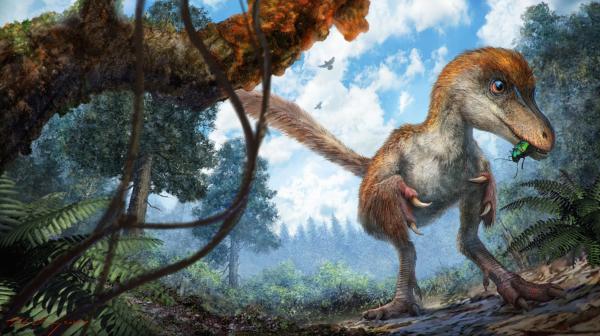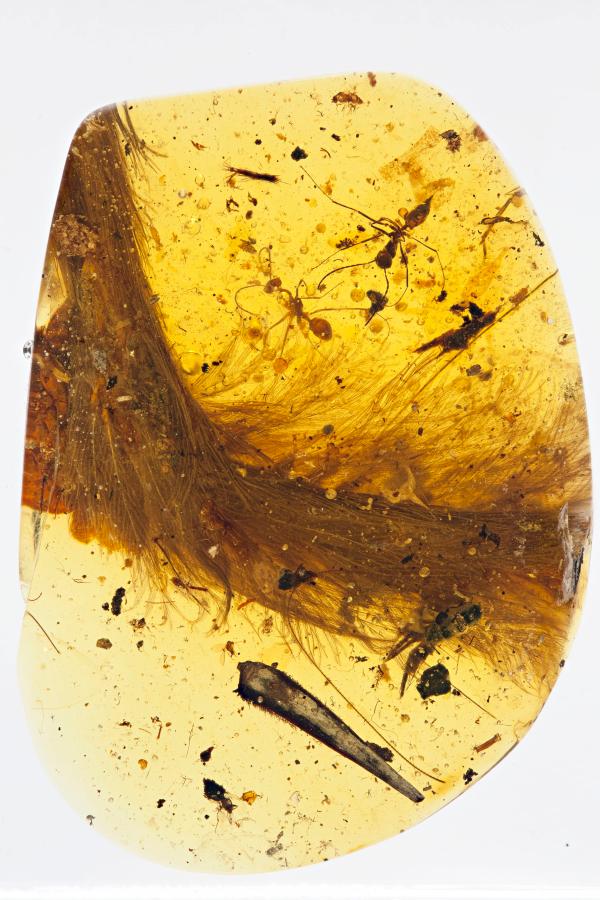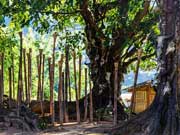


A recovery drawing of the dinosaur in amber. (ThePaper.cn/Cheung Chung-tat)
Scientists from China and Canada have discovered the world's smallest non-avialan dinosaur fossil, preserved in amber, ThePaper.cn reported.
A paper titled "A Feathered Dinosaur Tail with Primitive Plumage Trapped in Mid-Cretaceous Amber" was published online by the international academic journal Current Biology on Dec. 9. The specimen is a tail about 3.85 centimeters long. Based on the size of similar dinosaurs, researchers have inferred that the dinosaur to which the tail belonged was about 18.5 centimeters in length.
Researchers named the specimen "Eva." Dr. Xing Lida from China University of Geosciences and Professor Ryan C. McKeller from Canadian Royal Saskatchewan Museum jointly led the research team. Xing told a reporter that it might have been a young dinosaur's tail, with a body that would have gotten bigger when it grew up.

An overview of the tail specimen in amber. (ThePaper.cn/Royal Saskatchwan Museum (RSM/R.C.McKellar))
"We have to say it's the smallest non-avialan dinosaur, rather than the smallest dinosaur, because all birds are evolved from dinosaurs," Xing clarified.
Researchers got the specimen from a Burmese amber businessman in 2015. Age determination shows that the amber fossil was formed about 99 million years ago.
"From that time, feathered vertebrates are either ancient birds or dinosaurs," said Xing.

Micro CT scan shows details of the tail bones and feathers. (Photo/ThePaper.cn)
Zeng Guowei, one of the authors of the paper, said, "We cannot determine whether it's a young dinosaur or an adult based on the current skeletal morphology." The specimen contains no signs of struggle or rotten features, indicating that it was wrapped in resin soon after its death. Its cause of the death might have been natural, or perhaps at the hands of a predator.
The paper pointed out that this specimen sheds new light on the appearance and evolution of dinosaur plumage, providing a direct association between amber-entombed plumage and body fossil material.

 Who Will Fit The Chinese Roles In Game Of Thrones?
Who Will Fit The Chinese Roles In Game Of Thrones? China's Hubei Shennongjia added to World Heritage List
China's Hubei Shennongjia added to World Heritage List Cute Dog At Fruit Stand Becomes Latest Internet Sensation
Cute Dog At Fruit Stand Becomes Latest Internet Sensation Top 10 livable Chinese cities
Top 10 livable Chinese cities The last primitive tribe in China
The last primitive tribe in China China's first intelligent security robot debuts in Chongqing
China's first intelligent security robot debuts in Chongqing A Total of 3,552 Subscribers Vanish In Two Days; YouTube Closes All Doors to Users’ Inquiries
A Total of 3,552 Subscribers Vanish In Two Days; YouTube Closes All Doors to Users’ Inquiries Out of this world! Futuristic UFO-shaped yacht has its own garden and a stunning underwater viewing deck
Out of this world! Futuristic UFO-shaped yacht has its own garden and a stunning underwater viewing deck An old tea house in Chengdu
An old tea house in Chengdu Furious Customer Crushes All the Buns from Vendor Just Because He Was Given the Wrong Flavor
Furious Customer Crushes All the Buns from Vendor Just Because He Was Given the Wrong Flavor